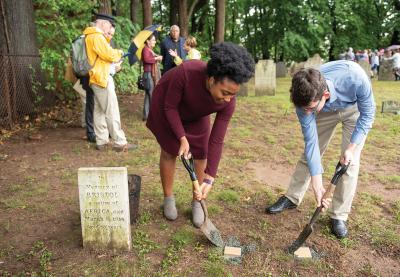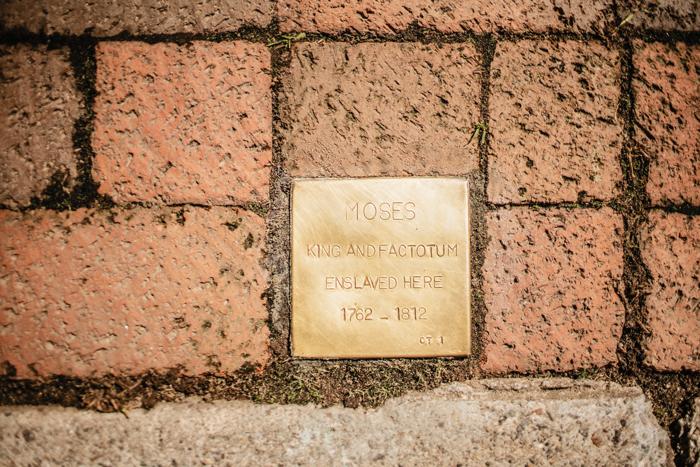Hana started her school paper with a description of Guilford’s town green—and for good reason. The beautiful, centuries-old space is the hub of this Connecticut coastal community. Residents like Hana, who attends Adams Middle School in Guilford, stroll beneath its shade trees, browse at the quaint shops on its perimeter and gather there for the town’s annual Holiday Tree Lighting.
But after alluding to its charm, Hana shifted her focus. “One would hardly believe,” she wrote, “that, centuries ago, this little town square was a stage for slavery.”
Many Americans still consider slavery an exclusively Southern institution. But Hana and her eighth-grade classmates at Adams Middle School are delving into a deeper, more accurate history of their overwhelmingly white New England town.
They learn that, before the Civil War, slavery was practiced in every Northern state. They find out that, in Guilford and other towns like it, ministers, merchants and other wealthy people often enslaved at least one person—sometimes an entire family. And although the number of people enslaved per household was typically smaller in the North than on sprawling Southern plantations, the students come to understand that the motivation for enslavement was identical on both sides of the Mason-Dixon Line: to increase profits by exploiting the labor of people held in bondage.
“This lovely town we live in was built on the backs of not only [people enslaved in Guilford], but people in the American South and people in the West Indies,” says Dennis Culliton, the social studies teacher who created the locally focused curriculum. “So the profits, the buildings we live in, this green that’s been preserved, the churches that you see—that’s where that wealth came from.”
Confronting the History
Culliton’s passion for teaching about slavery in Guilford was ignited when he read a biography of Harriet Beecher Stowe’s father, Lyman Beecher, in which the famous 19th-century minister referred to slavery in Guilford during Revolutionary times.
“I stopped, took a breath and said, ‘I don’t know anything about slavery in Guilford—or in Connecticut,’” Culliton says.
He also observed that, typically, history curricula reflect a version of history that centers white experiences and perspectives.
“It doesn’t always feel like there’s something missing in our curriculum [until] you go out to look for history that’s centered around people of color,” he says.
With that goal in mind, Culliton plunged into research, examining census data and probate records, and eventually gave a talk on his findings at the public library. Douglas Nygren was one of approximately 140 Guilford residents who attended the talk. Months later, after he took a trip to Berlin, Nygren contacted Culliton; he had to tell the teacher about Stolpersteine.
Nygren learned during his travels that, in 1993, German artist Gunter Demnig began creating 4-by-4-inch bricks, placing each in the ground in front of homes of victims killed by the Nazis. A brass plaque covering each Stolpersteine, or “stumbling stone,” was inscribed with the victim’s name, birth year and other information. More than 70,000 stones have been installed in 24 countries.
“Being a therapist [specializing in trauma], I know people have to deal with this, and the same is true of nations,” Nygren says. “I started to look at our own country and saw we haven’t dealt with our own history of slavery.”
Inspired by Demnig’s model, Nygren, Culliton and several Guilford residents started the Witness Stones project. The group focuses on researching the people who were enslaved in their town and honoring them with physical markers.
From the beginning, participants knew the project and the curriculum had the potential for great impact. But they also worried that some residents, students and family members would reject their efforts, preferring to attribute Guilford’s affluence—and that of Northern colonies and states more broadly—solely to hard work and talent, rather than to the unpaid labor of enslaved people.
Indisputable Primary Documents
One way Culliton preempted skepticism was to build his social studies unit around primary sources: 18th- and 19th-century wills, property and probate documents, and church records. He created document analysis sheets and a glossary of legal terms for students. With the help of their teachers, the entire eighth-grade class at Adams Middle School—300 students working in three teams—learned to decipher these documents.
It’s a demanding, creative process. Social studies teacher Thomas Bushnell says that when the unit was introduced in October 2017, he and language arts teacher Lauren Gullette “were literally with the kids, hands-on, figuring [documents] out ourselves.”
In analyzing the documents, students gained insight into the lives of three people enslaved in Guilford: Phillis, Candace and Moses. Each team researched the life of one person and used the jigsaw method to educate one another. They approached their research through five different lenses. They considered how the system of enslavement relied on dehumanization and paternalism, and on treating people as property. They also analyzed the economics of slavery. Finally, they looked for examples of agency and resistance in the lives of the men and women they studied.
After becoming familiar with the new vocabulary and the key concepts, the eighth-graders then began working on the culminating project of the three-week unit: writing a biography.
As they researched the lives of Phillis, Candace and Moses, the students found their stories were complex and heartbreaking. Phillis, for example, had been kidnapped and brought to Guilford by an 18th-century merchant and enslaver named David Naughty. Naughty also enslaved a man named Montrose. Phillis, Montrose and their children, Candace and Moses, were enslaved in the merchant’s home on the town green for decades. Today, students know the site as the location of Guilford Savings Bank.
In November 2017, the students also led the town’s first Witness Stones installation ceremony, honoring Phillis, Candace and Moses, three previously anonymous residents.
Providing the Words
At a teachers’ workshop Culliton organized last summer, Dr. Tracey Wilson, West Hartford’s town historian and a longtime teacher, remarked, “It takes confidence as a teacher to do this.”
Before she retired several years ago, Wilson taught a human rights course at West Hartford’s Conard High School for 20 years, as well as a course titled U.S. History Through the African-American Experience.
“Some people say, ‘We’re not going to talk about slavery because it’s too hard, and we may say the wrong thing,’” she says. “I think part of this whole [Guilford] project is that it gives teachers the words and the materials to get comfortable doing this.”
A unit about the lives of people enslaved in their hometown may be emotionally loaded, but the narrowness of its focus sharpens its impact. Frederick Douglass’ and Harriet Tubman’s lives offer powerful narratives, but only time separates Guilford students from Phillis, Candace and Moses. They walked the same paths the eighth-graders follow today.
At Adams Middle School, the Triangular Trade is no longer an abstraction, a set of arrows in a textbook linking continents and regions. Examples of its impact on the lives of enslaved people are legible in each of the documents students study. And evidence of its benefits to white people is visible in every elegant historic home the students pass as they walk through town.
History teacher Thomas Bushnell says there was a “different kind of energy” in his room last year. Taking what formerly seemed like a faraway Southern practice and placing it squarely in their own backyards, the new curriculum has dramatically reframed the institution of slavery for students.
“One of the beauties of this process is that we can’t keep pointing our fingers at other people and saying they need to change,” Culliton says. “We can’t say, ‘The South is bad and we’re good,’ if we have our history that we’re hiding. ... Before we engage other people, we need to do this right here in Connecticut. Not only in Connecticut but right here in Guilford.”
Frank is a Hartford-based writer and co-author of Complicity: How the North Promoted, Prolonged, and Profited From Slavery.
Guilford and the Key Concepts
The biography project at Adams Middle School touches on nine out of 10 “Key Concepts” Teaching Tolerance recommends in our Teaching Hard History framework:
1. Slavery, which was practiced by Europeans prior to their arrival in the Americas, was important to all of the colonial powers and existed in all of the European North American colonies.
2. Slavery and the slave trade were central to the development and growth of the economy across British North America and, later, the United States.
3. Protections for slavery were embedded in the founding documents; enslavers dominated the federal government, Supreme Court and Senate from 1787 through 1860.
4. “Slavery was an institution of power,” designed to create profit for the enslavers and break the will of the enslaved and was a relentless quest for profit abetted by racism.
5. Enslaved people resisted the efforts of their enslavers to reduce them to commodities in both revolutionary and everyday ways.
6. The experience of slavery varied depending on time, location, crop, labor performed, size of slaveholding and gender.
7. Slavery was the central cause of the Civil War. (This is the only key concept not included in the Guilford project because this study of slavery is completely independent of the Civil War.)
8. Slavery shaped the fundamental beliefs of Americans about race and whiteness, and white supremacy was both a product and legacy of slavery.
9. Enslaved and free people of African descent had a profound impact on American culture, producing leaders and literary, artistic and folk traditions that continue to influence the nation.
10. By knowing how to read and interpret the sources that tell the story of American slavery, we gain insight into some of what enslaving and enslaved Americans aspired to, created, thought and desired.
Including 18th-century documents and focusing on primary sources, the project as a whole lets students build understanding in Key Concepts 1 and 10. Each aspect of slavery researched in small groups also aligns with at least two of the framework’s key concepts:
Treating people as property: Key Concepts 4 and 5
Dehumanization: Key Concepts 4 and 6
Paternalism: Key Concepts 3 and 8
Economics: Key Concepts 2 and 4
Agency and resistance: Key Concepts 5 and 9




1 COMMENTS